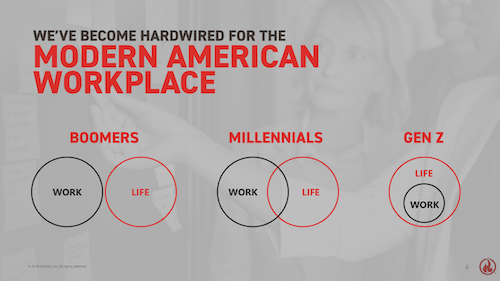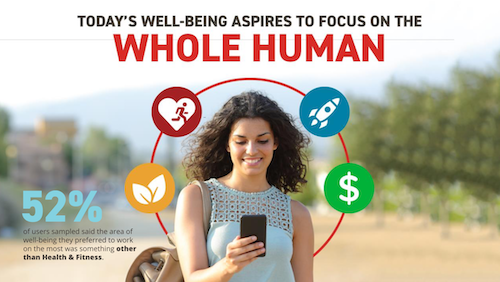For the first time ever, five generations are working side-by-side at the office.
The reason for this phenomenon?
In part, it’s because people are waiting longer to retire. By 2024, nearly 25 percent of the workforce is projected to be older than 55, according the U.S. Bureau of Labor Statistics. In 1994, that same age group only constituted 12 percent of the workforce.
That presents a unique challenge to human resource managers, who are tasked with serving a diverse population with different needs and views about work.
To serve this new multigenerational workforce, you’ll need a new strategy — one that will go beyond the old, antiquated approach of once-a-year wellness assessments and toward continuous feedback loops that paint a fuller picture of who your employees are and what they need.
The Five Generations
Many workplaces today are comprised of five generations, including:
- Traditionalists — Born before 1946
- Baby Boomers — Born between 1946 – 1964
- Generation X — Born between 1965 – 1976
- Generation Y (Millennials) — Born between 1977 – 1997
- Generation Z — Born after 1997
Each generation has a different perception of the world — and the workplace. That’s to be expected, of course, as their views have been shaped, in part, by the culture, events, and experiences of their time.
How They View Work
Baby boomers looked at work and life as two separate things. They went to a job, worked hard all day, and then clocked out and went home to their families. For many baby boomers, the work day had a clear end and beginning.

Not so for millennials, who entered the workforce at a time when technology had advanced greatly. Work became “portable” through the use of laptops, tablets and smart phones. That put the pressure on millennials to keep working after office hours — introducing the work-life balance struggle. The line between work and life became blurred.
Gen Z, however, wasn’t thrust into that world — they were born into it. They taught themselves new skills by watching YouTube, conducting research on Pinterest, or reading blogs. They saw college friends forgo job interviews at big companies to start their own — and succeed. And they picked up followers on Instagram and clients from Facebook groups. Work is a core part of their life and their self-identity. The line isn’t blurred. There isn’t one.
Using Flourishing Data To Serve a Multigenerational Workforce
Just as the workforce has evolved over the years, so should our approach to serving it. The results are in: Wellness programs that only focus on your employees’ physical health — in an effort to reduce healthcare spend — don’t work anymore.
To be honest, we don’t think they ever did.

Biometric numbers, including your body mass index, blood cholesterol, and blood glucose levels, only tell part of your employees’ story. The bigger picture can be seen by collecting human flourishing data, which measures how your people are doing in all aspects of life — beyond just their physical health.
Here are three ways you can use human flourishing data to advance your well-being program — and make it relevant to today’s multigenerational workforce:
1. Bridge the cross-generational gap by creating opportunity for meaningful engagement.
There’s plenty of misconceptions out there about each generation. You might have employees that think their Gen X co-worker puts his own needs before the team’s needs. Or that their baby boomer co-worker doesn’t get social media. Or maybe they think that their millennial colleague doesn’t own a pair of shoes other than flip-flops.
These assumptions can create a breakdown in communication and leave employees feeling isolated. Through the Flourishing Index, you can shed light on areas in which your employees are flourishing — and areas where they might need support. We leverage a validated flourishing assessment (a short, 12-question survey) to reach out to your employees throughout the year using our mobile app. These insights can then inform your programs in real-time.
For example, if you find that employees rank themselves low on “Close Social Relationships” questions, you could deploy teambuilding activities that inspire more meaningful interactions. Once a year, you might split employees into teams (ideally with people beyond their immediate department) and assign them a group theme, such as an Olympic sport. One team might be “gymnastics” another “hockey,” and so on. Together, they have to embody that theme through a group costume, office decorations, activities, or food items. Then pick a day for some healthy competition and give out prizes to some of the standouts.
Team-building activities can help your multigenerational workforce make meaningful connections, which can then enhance the way they work together and communicate as a group.
2. Gain insight into what benefits may help high performers stay — and bring in new talent — from every generation.
Most millennials and Gen Zers define financial success the same way — and it has nothing to do with being rich. Nearly 60 percent defined it as being debt-free, according to a recent Merrill Lynch Wealth Management report. Student loan debt has caused both generations to delay buying a home, starting a family, or saving for retirement. To support their employees, both start-ups and corporate juggernauts — including IBM — have started offering student loan debt repayment benefits. On the other end of the spectrum, nearly half of Baby Boomers (45 percent) have nothing saved for retirement, indicating another opportunity for employer support.
Through the Flourishing Index, you can shed some light on your employees’ “Financial and Material Stability.”
You can then take those findings and determine what benefits might better align with your employees real needs, such as a financial consultant that can help them develop a “get debt-free” plan or a 401(k)-matching program.
3. Make an internal and external impact.
We all want to feel like our work and life serve a greater purpose. Through the “Meaning and Purpose” questions we’ll ask, you can get a gauge of whether or not your employees feel a strong sense of purpose in life. If they don’t have a sense of purpose in life, how will they ever have one at work?
If you identify this to be an area of opportunity for your population, you might consider launching a company-wide community service day — or even an ongoing community service program. You could even poll employees to ask about the causes they care about most, whether it’s building homes for the less fortunate or raising funds for veterans.
In 2014 and 2015, the Millennial Impact Report examined millennial behaviors and attitudes toward involvement with giving, volunteering and social good, specifically as it occurred in the workplace. Those studies found that 94 percent of millennials liked using their skills to benefit a cause — and 77 percent preferred working on service projects with fellow employees rather than engaging in them independently.
By shifting your focus from decreasing health spend to helping people flourish, you’ll be able to create a well-being program that inspires real, meaningful change. Those changes will have a lasting impact on your employees’ lives — and on the success of the greater organization.

